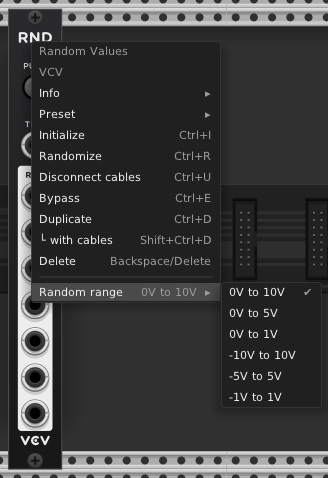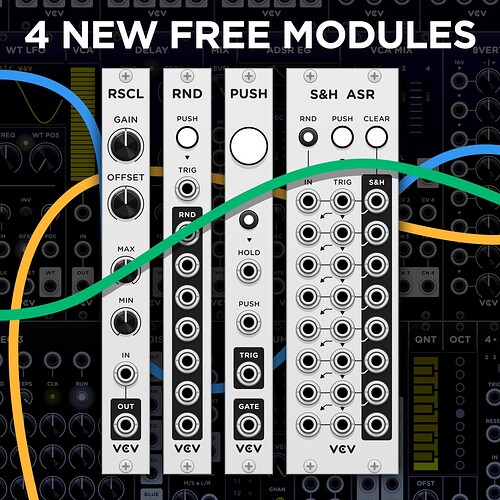Today we give you 4 new free modules. Update now to try them out!
Nice to see these with dark panel option, when will the paid premium module panels be updated?
Calling it: my new fav Shift Register
Very useful additions!
RND is almost perfect! But I hope to see the Min/Max knobs on the future RND2. ![]()

Oh yes, this is shift register looks fun. Always need more shift registers.
Related, it would be great to have shift registers as a tag, since there are a few in the library now.
Very nice, thanks Andrew! Especially that S&H + Shift register looks very nifty, up to 4 shift registers in one!
Good idea, at least for now we can select range from the right-click menu

Another nice addition
Some thoughts:
S&H ASR
I am with others - this is my favorite of the new modules. Simple well thought out concept and design, yet flexible and fairly deep.
I think a Clear (Reset) CV input would be a welcome addition. Support for polyphony might also be interesting - it would be an interesting design challenge to establish polyphony rules with all the normaled inputs.
RND
This one is more powerful than you might expect, even after reading the manual. There is one key piece of information missing from the documentation…
RND is fully polyphonic! The number of channels at the TRIG input determines the number of output channels at each output port. So it can generate up 16 x 7 = 112 random values at one time. For example, sending 16 channels of constant 0V to TRIG and then pressing the PUSH button generates 16 new random values at each output port. Or sending a trigger to channel 3 of the TRIG input generates a new random value on channel 3 of all output ports, while leaving all other polyphonic channel outputs alone.
It might be nice to have a context menu option to specify the number of output channels desired.
Not quite as flexible as independent knobs for min and max, but the context menu does offer various output ranges: 0 to 10, 0 to 5, 0 to 1, -10 to 10, -5 to 5, and -1 to 1 (I see ToYaGa beat me to the punch as I was composing this)
PUSH
I think this will become my favorite simple button module capable of generating gates or triggers. I like the scale of everything, and it is surprisingly deep.
The documentation hints at this, but it might not be obvious - the HOLD button/input can function as a flip flop. A button press or a trig at the input toggles the hold state.
There is one surprising behavior - Sending a high gate to the HOLD input toggles the state as expected. But pushing the HOLD button while the gate is high will still toggle the state! I kind of expected the button to be non-functional as long as the CV input was high.
In contrast, a high gate at the PUSH input effectively disables the PUSH button. The high PUSH gate inverts the state, and pressing the button while the gate is high has no additional effect.
RSCL
I see some value - having the option for high gains of 100x and 1000x is unusual and potentially useful. Also, the independent MIN, MAX with optional reflection is kind of cool.
But I feel like there is a lot of missed opportunity on this one.
I would like to see any of the following additional features (I think this deserves to be 5hp instead of 3hp)
- Option to apply the offset before the gain, or have independent pre gain offset and post gain offset
- CV input for Gain, Offset, Min and Max
- An option for anti-aliasing so it could be used as an audio wave-folder without introducing unwanted aliased frequencies.
Think I’ll carry on using Normaliser as it does have CV control over min and max. It doesn’t have gain or offset, but that’s easy enough to acquire elsewhere.
You could put the output through another module, like the Audible Instruments Quad VC-polarizer (aka Blinds) to change the min / max?
Hi Dave, thanks for your input! absolutely valuable as always ![]() these suggestions are interesting and will be discussed.
these suggestions are interesting and will be discussed.
A few bits: here and there
SH ASR: really curious what creative people will do with this one: it can be seen as 8 SHs, or 1x8 steps ASR, or 2x4st ASR, or 3SHs + 2stpASR + 3stpASR, it can be a 8step ASR with each different clock div, or source… a fun trick with this one: set RND active and hit push 8 times to fill all buffers with random values and loop it back and clock it: you have a repeating random 8 step sequencer.
… or 2*4 steps sequencer ![]()
RND: the simple little thing i like is the trigger button: usually we clock random generators values changes at every beat. this fun and this one can do that, but we wanted to encourage a manual search of “the right” random value, hit the button until you like the result and, and keep it as it is. the random values are saved with the patch so it can really have a defining role of the happy accident that is being kept along the way.
PUSH: if hold is active, the push button reverses the state, it comes very handy when doing temporary muting, or bypassing an effect or adding new info in a “freeze” style loop (clouds, reverbs, …)
RSCL: could you elaborate on a situation that would only be possible with offset before gain? I am not sure I can picture it. CV control would have been nice, but it shouldn’t be an overkill for all simple uses of rescaling ![]() hard choices! … or room for a new Venom module?
hard choices! … or room for a new Venom module? ![]() that would be great! I personally love the reflect option, I think it’s the hidden gem of this CV processor and I am looking forward to see what fun stuff will be done with it. Audio processing (and anti alias) is tempting to make it a wave folder, but it would be a very harsh one, not because of anti alias, but because there is no control over smoothness of the edges, no soft clipping or “non linearities” that makes wave folder so interesting for audio processing. Such effect should be a module of its own, with DSP, circuit modeling, control over the effect, …
that would be great! I personally love the reflect option, I think it’s the hidden gem of this CV processor and I am looking forward to see what fun stuff will be done with it. Audio processing (and anti alias) is tempting to make it a wave folder, but it would be a very harsh one, not because of anti alias, but because there is no control over smoothness of the edges, no soft clipping or “non linearities” that makes wave folder so interesting for audio processing. Such effect should be a module of its own, with DSP, circuit modeling, control over the effect, …
Thanks again for your comments ![]()
Absolutely - that is also a key feature of my Rhythm Explorer module. In a similar way it saves the pseudo random number generator seed so you can return to your happy discovery when you reopen the patch. I also provide the seed value as an output so it can be stored in something like the Impromptu CV-Pad. You can store a whole array of interesting seed values and call them up on demand.
Another nice feature that I also implemented in Rhythm Explorer. The Run button normally toggles the run state. But the Run CV input expects a gate, not a trigger. If the Run CV is patched and low, then the Run button momentarily turns the sequencer on. If the CV is high then the Run button momentarily turns the sequencer off. I agree, it is a nice performance tool.
Back to PUSH - I’m still surprised the Hold button responds while the Hold CV is high. I don’t have a problem with it, just surprised.
My main use case is converting bipolar to unipolar, or vice-versa, followed by scaling. As long as the offset is done first, then the offset amount remains constant, regardless what amplification/attenuation you use. But if you do the offset after ward, then the offset has to change as the scale factor changes.
I agree, it is a nice feature. (and even better with CV inputs!) I agree the wave folding is naïve, but I still think it is useful with anti-aliasing. I have been toying with the idea of creating a Venom module that does offsets, scaling, clipping/reflection, etc. for a while. I have mocked up the features with existing modules - predominantly Recurse and WinComp. The WinComp has oversampling available, and it can make a huge difference in the wave folding result.
Here is a quick demo showing how my mockup gives nearly identical results to RSCL when oversampling is not engaged, as well as the dramatic improvement when it is engaged. It is amazing what a difference x2 oversampling can give. WinComp goes to x32, but I didn’t bother going past x2.
Venom vs VCV Wave Folding.vcv (3.9 KB)
My ancient “Shaper” always had an oversampled wavefolder, fwiw.
I think that is a well known given!




